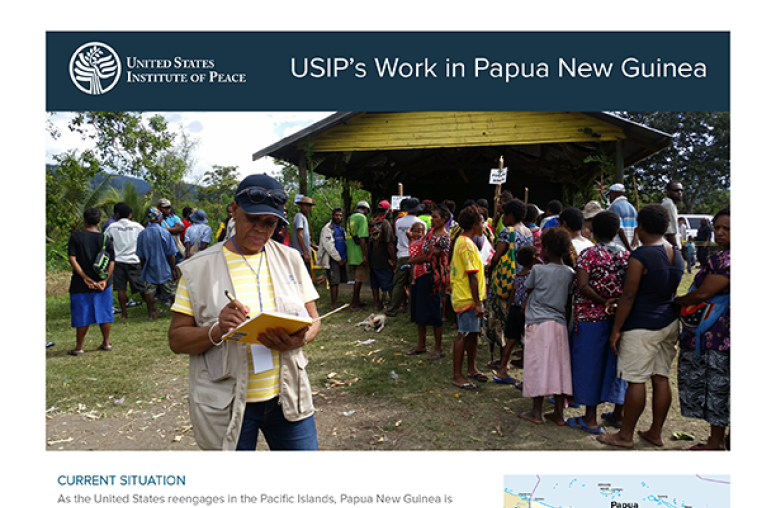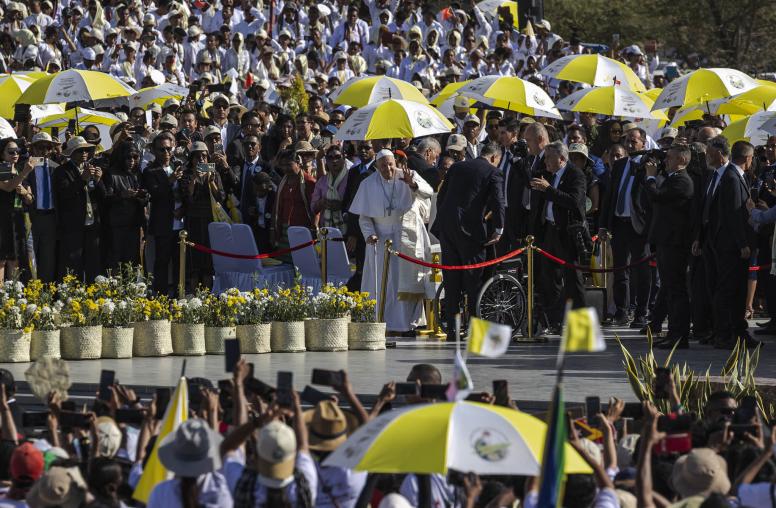Deepening the U.S.-Papua New Guinea Relationship
Given recent pushback against U.S. initiatives, Washington has its work cut out.
As the largest, most populous and most strategically located nation in the region, Papua New Guinea (PNG) is, not surprisingly, at the epicenter of reinvigorated U.S. efforts to reengage the Pacific Islands. The year 2023 has been a big year for the U.S.-PNG bilateral relationship. However, given recent pushback against U.S. initiatives in PNG, deepening the relationship will require some work.

Enhanced Cooperation
The bilateral relationship was taken to another level in May when U.S. Secretary of State Antony Blinken visited PNG to sign the bilateral Defense Cooperation Agreement (DCA). At the signing of the DCA, the State Department pointed to a suite of new programs that focus on climate and disaster relief, shiprider programs addressing illegal fishing and other criminal activity. Following Blinken’s visit, U.S. Defense Secretary Lloyd Austin traveled to PNG’s capital Port Moresby in July to work with PNG Prime Minister James Marape on enhanced defense cooperation. This included a new Coast Guard cutter put into action in August to combat illegal fishing and international crime carried out in PNG waters, but most far-reaching was the objective of modernizing the PNG Defence Force with “new equipment, more training and upgrades to defense facilities.”
On top of this significant upgrade to U.S.-PNG defense cooperation in 2023, the United States has been a presence in PNG on the economic and human development front as well. PNG was the only Pacific Island nation added to a grouping of seven African nations and Haiti in the Global Fragility Act (GFA) passed by the U.S. Congress in 2019. This effort was augmented in 2023 with the release of the 10-year U.S. Strategy to Prevent Conflict and Promote Stability. Like the GFA, this strategy targets the same seven African nations (Libya, Mozambique, Benin, Côte d’Ivoire, Ghana, Guinea and Togo), Haiti and PNG. For PNG, the strategy undertakes to address specific areas of preventing “chronic violence” and institution strengthening. U.S.-backed programs, often in collaboration with nongovernmental organizations, have been making notable gains in this area, not least in arguably the most vexed of all, gender-based violence. Yet other important legislation intended to revolutionize U.S.-Pacific Islands region engagement that would directly infuse PNG with resources and linkages into U.S. economies, the Blue Pacific Act, looks set to be stillborn with one authoritative source giving it a 2% chance of being enacted by Congress.
The U.S. presence in PNG is also marked by the prominence of private corporations. ExxonMobil, with its immense liquefied natural gas project, leads a deep U.S. corporate field while also pioneering a model for community capacity building, commercial agriculture projects, community health and workforce development. In 2023, Google made an entry into the Pacific Islands region when it announced it would be building undersea internet cables that will serve significant defense, economic and human development purposes throughout the region. PNG will be one of 12 Pacific Island nations linked in this latest project directly intended to outcompete China. This regional infrastructure follows the 2018 PNG electrification project where the United States partnered with Australia, Japan and New Zealand in a joint effort to mitigate Chinese influence, like other projects rolled out over the past five years.
Recent Pushback against U.S. Initiatives
With all this U.S. attention on PNG, it came as a somewhat unpleasant surprise that U.S. initiatives were met with considerable pushback from within PNG in 2023. When the wording of the DCA was leaked in May, it triggered a firestorm. Opposition politicians stressed they had not been consulted about the terms or the document’s wording. In particular, the provision that the United States would enjoy “unimpeded access” to six key ports and airports sparked claims that the DCA violated PNG’s sovereignty. Protests, led mainly by students, ensued. The question about the constitutionality of the DCA was sent to the PNG Supreme Court by the opposition in August for determination. A substantive hearing on its constitutionality is due in 2024.
Following the reaction to the DCA, when the U.S. Embassy in Port Moresby flew the Pride flag in June, it triggered another domestic political storm. Although the U.S. Embassy had flown the flag in past years, the public response in 2023 demonstrated a wariness toward the United States triggered by the DCA. As a direct result of the backlash over the DCA, Australia scaled back a proposed security treaty with PNG, instead signing a safely worded Bilateral Security Agreement in December.
Clearly more work needs to be done for Washington to better understand PNG to advance understanding and ensure the ample needs of PNG’s populace are effectively addressed by the United States. One monumental variable is PNG’s exploding population. Population growth reveals the limits of PNG’s governmental reach (the issuance of birth certificates, for instance, is haphazard) as well as a myriad of other issues related to health and education. Currently, PNG’s population is estimated to be between 10 million and 17 million, with estimates changing by many millions over the past year.
How can Washington better understand PNG? How can the United States do better to engage with this highly strategic nation that defies categorizations and never ceases to present challenges and opportunities?
A View from Papua New Guinea
PNG is the largest Pacific Island nation in terms of population, size and resources. Since its independence from Australia in 1975, successive governments have remained left leaning, opting for big government polices to drive the development agenda, education and health, and actively participate in foreign direct investments.
The prototype PNG policymaker in 1975 saw the United States through the prism of Canberra — the preferred keeper of world order and backstop of Australia; outsourcing its defense posture and walking with Australia in regional matters. There were times when PNG took its own path. This included devising not only regional norms but international systems on fisheries, and aligning with the Global South on trade, biodiversity issues and, of course, climate change, the Holy Grail of the Pacific Islands’ regional priority.
The intervening generations kept the “Australia front end, U.S. back end” view up until 10 years ago when new, flexible instruments of trade, investment and infrastructure started to replace the multilaterals and Australia. Roads, cables, ports, bridges, schools and skills became readily available. These weren’t confined to government projects; the private sector took part in the bonanza. The market changed dramatically. PNG was no longer an Australia-led partner. A new, stronger, more powerful and richer friend, China, was pouring its time, money and people into the PNG story.
Although Australia and U.S.-led multilaterals have spearheaded somewhat of a counteroffensive, many observers in PNG are not convinced this construct will make any meaningful impact as an alternative to China. Only the United States can play that role, and the renewed U.S. interest in the region has policymakers sitting on the edge of their seats.
The U.S. military and security posture must be embedded in PNG’s Medium Term Development Plan IV’s Strategic Priority Areas (SPAs) of rule of law and justice and national security. This will complement efforts by the PNG government’s social and national security sector to promote the rule of law, protect basic rights and further shared values of advancing human development.
As well as enriching cultural connections, the United States needs to construct a vibrant and dynamic facility on economic, trade and investment partnership. PNG’s plan for the SPAs ambitiously invites partners around the world to develop the nation’s natural and people resources. China and Australia are augmenting their partnership and initiatives with PNG to align with this plan, and so should the United States.
An AGOA for the Pacific Islands
For the United States, a sensible starting point would be a version of the African Growth and Opportunity Act (AGOA), the George W. Bush administration-era legislation, recontextualized for the Pacific Islands region. Massive potential lies in agriculture, fisheries, technology, construction, oil, critical minerals, tourism and other service sectors that can bring the United States and PNG’s private sectors together. A good example of this collaboration is PNG’s preference to use U.S. technologies in a variety of critical digital infrastructure systems in government and business. The public service actively uses Amazon Web Services for its cloud capabilities, Microsoft for secure data exchange and Google supplies education materials to 4 million children. Facebook and WhatsApp are the billboards holding the powerful to account and, like everywhere else in the world, expressing the sentiments of the community. Cisco connects complex pipelines and engineering systems in the energy, water, oil, gas and mining industries. The banking sector, powered by Oracle, serves millions across the country.
These examples demonstrate the massive potential of U.S. innovation to act as a positive force in PNG. Investing in the future prosperity of PNG will also pay dividends by preserving U.S. interests in the Pacific Islands region.
Douveri Henao is CEO and founder of Legacy Group, a Papua New Guinea-based geopolitical consulting firm. He is a former executive director of the Business Council of Papua New Guinea.
Patricia O’Brien is an adjunct professor in the Asian Studies Program at Georgetown University.



